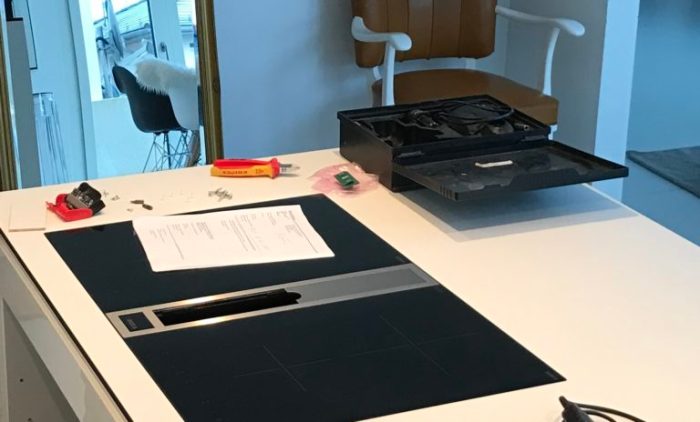We moved into our new house four years ago. Now, for the second time in four years, our extractor fan/ hood collapsed and we had to call the maintenance service. Here comes the tricky part: The fan is one of the new types – without an extractor hood. What a great invention for style and comfort for people of my height!
Sadly, there is a downside to it. The entire kitchen, with all equipment we purchased from a kitchen installer and carpenter house. (A local one, not a large chain.)
The kitchen installer pushed my request to the manufacturer of the fan. After 2 weeks of cooking without the fan, the fan manufacture managed to come by our house, only to find out that they cannot access the fan motor without opening the installed kitchen. So we had to arrange a second party, this time with three people: the kitchen installer, the fan manufacturer and me. You need to know that the service manager from the fan manufacturer was not the same person from the earlier dates.

What do you know about your customer?
This is our my recent dialog in my kitchen went, when a service manager came by our house:
- Service manager: I have no information about your problem. What’s not working?
- Me: Well I called your service center several times and a colleague was visiting me two weeks ago.
- Service manager: I have no information. I don’t have all spare parts with me.
- Me: I cannot believe this, I already told your colleagues what my issue is.
Dear readers of my blog, I don’t want to bother you with my kitchen and home stories. This supply chain relationship clearly showed me that both companies have room to improve in a key area: Collecting information and sharing information, to ensure the happiness of their clients (in this case, me.)
In the time digital and data, is it this complicated to store information about me – my customer profile, my purchase history, my warranty? Why can’t they have a consistent 360 view of their customer, Ben Rund, across their touch points (call center, service manager, and retail partner?)
Recommendations make all the difference
According to this MyKinsey article, 35% of Amazon.com’s revenue is generated by their recommendation engine. At the end of the day, recommendations and ratings matter – Offline, online or omni-channel. I was very happy with the kitchen installer in the early days, and even recommended them to a friend who went and made a purchase there. Same for the fan brand. But, with the service level going down, I will now think twice before recommending them again. What if both companies could see the potential within my network? What if they could leverage this potential for influencer marketing?
Connected kitchen
IDG predicts that there will be 200 billion devices connected to the internet by 2020. (I am sure it will be even more!) I have to admit, my kitchen is not yet connected to the internet of things, but I am sure it will be soon. Did you know that post organisations are working with manufacturers of dish washers to develop a thin envelope or box which can carry 10 dish washer tabs and fit in an average post mail box? With the dish washer being connected to the internet (which makes it a IoT device) it can trigger an order to ship a now box of 10. This is digital transformation and even cooler than Amazon Dash, in my view.
What stays?
Having the service manager ring twice at my home annoys me. Having me ring them up more than two times annoys me even more. What if they were able to have single view of me, my household, my products, my retail partner and my next logical purchase?
PS: It has now been five weeks and the issue remains unsolved. We have stopped cooking. Master Data Management (MDM) can be your engine to make customer experience and maintenance services work smart, be connecting the dots across things, parties and places.